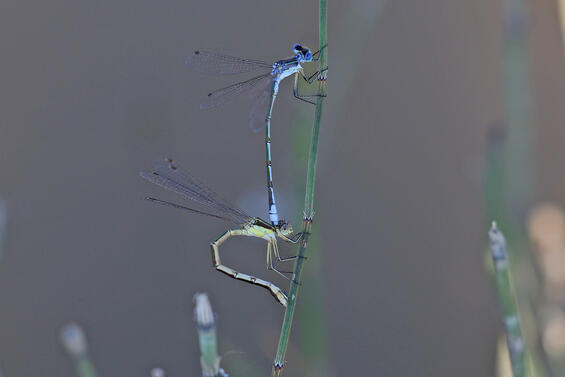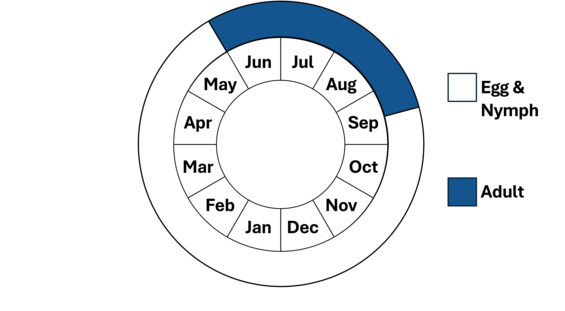- Scientific name: Lestes unguiculatus
Species of Greatest Conservation Need (MA State Wildlife Action Plan)
Description

Male (top) and female (bottom) lyre-tipped spreadwing
The lyre-tipped spreadwing is a small, semiaquatic insect of the order Odonata, suborder Zygoptera (the damselflies), and family Lestidae (spreadwings). Lyre-tipped spreadwings have large eyes on the sides of the head, short antennae, and four heavily veined wings, which are kept partially open when at rest unlike other damselfly families. The male’s thorax (winged and legged section behind the head) is dark bronzy with pale lime-green shoulder stripes. In most males, the bronzy thorax becomes pruinose blue-gray to gray with age. The abdomen is dark-green to blackish dorsally with a pruinose bluish-gray tip. The female is similar with thorax green dorsally with pale shoulder stripes and pale sides. The abdomen is green dorsally and pale ventrally. Lyre-tipped spreadwings range from 31-44.5 mm (1.2-1.7 in) in length.
Nine species of Lestes have been recorded in Massachusetts and identification of the various species can be very difficult and often requires close examination of the male terminal appendages (Nikula et al. 2007) or female ovipositor structure (Lam 2004), although the latter is more difficult. Definitive identification and its name, comes from the males lyre-shaped paraprocts which are divergent at the tips. The lyre-tipped spreadwing males are most similar in appearance to northern (L. disjunctus) and sweetflag (L. forcipatus) spreadwing but these species tend to have darker thoraces and abdomens and lack a dark triangle spot on segment 8 pruinosity in lyre-tipped. See Lam (2004) and Paulson (2011) for other differences.
Life cycle and behavior

Note adult life stage is synonymous with fight period.
Although little has been published specifically on the life history of lyre-tipped spreadwing, it is likely similar to other, better-studied species in the genus. All odonates have three life stages: egg, aquatic nymph, and flying adult. The nymphs are slender with three leaf-like appendages extending from the end of the body which serve as breathing gills. They have a large, hinged lower jaw which they can extend forward with lightning speed. This feature is used to catch prey, the nymph typically lying in wait until potential prey passes within striking range. They feed on a wide variety of aquatic life, including insects and worms. They spend most of their time clinging to submerged vegetation or other objects, moving infrequently. They transport themselves primarily by walking, but are also capable of swimming with a sinuous, snake-like motion.
Lyre-tipped spreadwings likely have a ≤1 year life cycle. The eggs are laid in summer and may hatch quickly during the summer or in the fall. The nymphs develop over the winter and spring, undergoing several molts. In early to mid-summer the nymphs crawl out of the water up onto emergent vegetation and transform into adults. This process, known as emergence, typically takes a couple of hours, after which the newly emerged adults (tenerals) fly weakly off to upland areas where they spend a week or two feeding and maturing. The young adults are very susceptible to predators, particularly birds, ants, and spiders; mortality is high during this stage of the life cycle. The adults feed on a wide variety of smaller insects which they typically catch in flight.
When mature, the males return to the wetlands where they spend most of their time searching for females. When a male locates a female, he attempts to grasp her behind the head with the terminal appendages at the end of his abdomen. If the female is receptive, she allows the male to grasp her, then curls the end of her abdomen up to the base of the male’s abdomen where his secondary sexual organs (“hamules”) are located. This coupling results in the heart-shaped tandem formation characteristic of all odonates. This coupling lasts for a few minutes to an hour or more. The pair generally remains stationary during this mating but, amazingly, can fly, albeit weakly, while coupled.
Once mating is complete, the female begins laying eggs (oviposits) in emergent vegetation by using the ovipositor located on the underside of her abdomen to slice into the vegetation to deposit eggs. Although the female occasionally oviposits alone, in most cases the male remains attached to the back of the female’s head. This form of mate-guarding is thought to prevent other males from mating with the female before she completes egg-laying. The adult’s activities are almost exclusively limited to feeding and reproduction, and their life is short, probably averaging only three to four weeks for damselflies. The flight period may range from June to September but may be more pronounced in Massachusetts as indicated by Rhode Island populations in July and into August (Brown 2020). As with its habitat, the species likely occurs sporadically at a site from year to year and may be an initial colonizer of temporary ponds before it gets outcompeted as other species later immigrate (Paulson 2011). Like other Lestes, the species perches on vertical stems of emergent vegetation and shrubs along the shoreline.
Distribution and abundance
The lyre-tipped spreadwing ranges west from northern California north to Canada and east through the Great Lakes region and into New England and the Canadian Maritime provinces. The species is rare in southern New England (Brown 2020). The status of lyre-tipped spreadwing remains uncertain in Massachusetts. Records of the species occur along the coastal plain, however all records are >25 years old and the species has not been observed since then. The rarity of the species in Massachusetts could be a true decline or a lack of overlapping survey effort that has targeted its ephemeral habitat (e.g., temporary pools).
Habitat
The lyre-tipped spreadwing inhabits small and open temporary ponds or vernal pools with aquatic vegetation. Occupied wetlands include gravel and sand pits, farm ponds, and other temporary pools.
Healthy habitats are vital for supporting native wildlife and plants. Explore habitats and learn about conservation and restoration in Massachusetts.
Threats
The major threats to lyre-tipped spreadwing are wetland, shoreline, and riparian habitat loss and degradation. This includes the degradation water quality and the alteration of water quantity. The mechanisms for habitat loss and degradation are numerous and include: forest cutting and the construction of buildings, roads, and other human built structures; run-off from agriculture, increased road salts, increased nutrient input, and other contaminants; high-impact recreational use such as off-road vehicles driving through shorelines and ponds; invasive plants (e.g., Phragmites) outcompeting native emergent aquatic species needed for egg-laying; excessive groundwater withdrawal especially during drought periods; and filling in or excavations of basins containing temporary pools. Climate change may also pose a threat by increasing drought periods and frequency.
Conservation
Survey and monitoring
Standardized and targeted surveys for lyre-tipped spreadwing is needed to determine its status in Massachusetts. Standardized surveys should target historical sites and new wetlands to determine species occupancy and population status. Surveys for adults are likely to be more effective for detection compared to nymph or exuvia as this life stage is extremely difficult to find and identify. Adult surveys should target nearshore and riparian habitats during their flight period during standardized weather and time windows to maximize species detection. Multiple site visits (e.g., ≥3) are likely required to detect this species because of its ephemerality. Routine monitoring of prioritized sites is needed estimate occupancy trends overtime.
Management
Protection and restoration of shoreline/littoral zone, riparian, and upland habitat is critical for lyre-tipped spreadwing in Massachusetts. Actions that can improve or prevent habitat degradation include: reduction of nutrient, agricultural, and road runoff; minimization of water level alteration that impacts native aquatic vegetation; minimization of groundwater withdrawals particularly during drought periods; prevention and management of nonnative aquatic vegetation; development of best practices for herbicide use; limitation and enforcement of off-road vehicles on shoreline habitat; and connection between ponds.
Research needs
Research effort is needed to estimate detection and occupancy rates and how other environmental variables (e.g., sample timing, weather) affect these rates. Through standardized surveys, effort is needed to define habitat requirements, distribution, and relative abundance. Identification of source and sink wetland sites and general population dynamics within and across pond complexes is needed in Massachusetts to prioritize site conservation. Other needed research efforts include estimation of physiological tolerances to insecticides and herbicides; impacts of invasive aquatic vegetation on populations; and projections of species distribution under climate change scenarios and climate vulnerability analysis.
References
Brown, V.A. 2020. Dragonflies and Damselflies of Rhode Island. Rhode Island Division of Fish and Wildlife, Department of Environmental Management, West Kingston RI.
Lam, E. 2004. Damselflies of the northeast. Biodiversity Books, Forest Hills, New York, 96 p.
Nikula, B., J.L. Ryan, and M.R. Burne. 2007. A Field Guide to the Dragonflies and Damselflies of Massachusetts. Massachusetts Natural Heritage and Endangered Species Program.
Paulson, D. 2011. Dragonflies and damselflies of the east. Princeton University Press, Princeton, NJ.
Walker, E.M. 1953. The Odonata of Canada and Alaska, Vol. I. University of Toronto Press.
Westfall, M.J., Jr., and M.L. May. 1996. Damselflies of North America. Scientific Publishers.
Contact
| Date published: | April 8, 2025 |
|---|